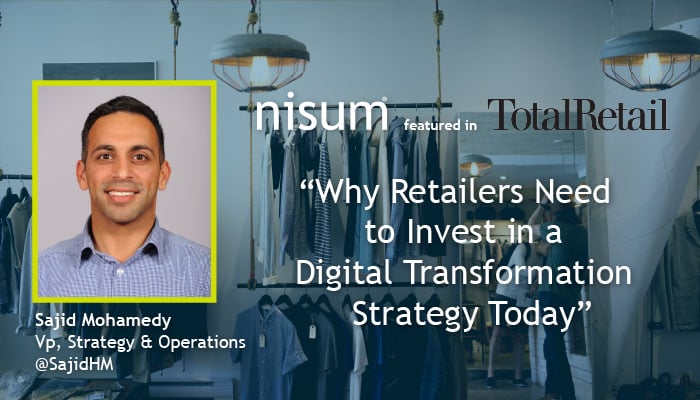In the Age of the Customer, organizations must create data-driven strategies to figure out what their customers want. In his Total Retail article, Nisum's Sajid Mohamedy explains, “Why Retailers Need to Invest in a Digital Transformation Strategy Today.” You can read the full text below or see the article on Total Retail here.

Why Retailers Need to Invest in a Digital Transformation Strategy Today
Two years ago, innovation expert Tom Goodwin penned an article for TechCrunch in which he observed the following phenomenon:
“Uber, the world’s largest taxi company, owns no vehicles. Facebook, the world’s most popular media owner, creates no content. Alibaba, the most valuable retailer, has no inventory. And Airbnb, the world’s largest accommodation provider, owns no real estate. Something interesting is happening.”
His words ring just as true today, if not more so, as they did in 2015. A retailer’s true competitive advantage is intangible; it lies in a business’ ability to meet customers where they are and seamlessly connect them with the products and services they are looking for, at the moment they are looking.
The Age of the Customer
Since the Industrial Revolution, American enterprise has operated within a number of evolving paradigms. At the beginning of the 20th century, we heralded the age of manufacturing. Then came the age of distribution in the 1960s, and then the age of information in the 1990s. By 2010, a very distinct yet seismic shift was occurring in the relationship between buyers (consumers) and sellers (organizations).
The relationship had always been very one-sided: Sellers were in charge of not only the product or service they were offering, but also the price, product or service information available to prospective buyers, and sales channel. Buyers were essentially only able to control their purchasing decision.
However, thanks to the rise in accessibility and sophistication of mobile, social and other digital technologies, this model has flipped. Today, buyers don’t solely rely on the product or service description provided by the company, they also source online reviews and their social networks for recommendations when considering a purchase. Savvy customers price compare across the web for a number of variables in order to purchase from the seller offering the lowest price, best shipping rates, no-fee in-store pickup, etc. Consumers also have the power to decide on their preferred sales channel, be it in-store or online. The only thing retailers retain complete control over is the product or service they are bringing to market.
Brands that are stuck in their ways and have yet to adapt their business strategy accordingly are putting themselves at a huge risk of learning their lesson the hard way. As a cautionary tale, we can look to United Airlines’ recent headline-making fail, in which a customer was forcibly and violently removed from an aircraft because airline employees had booked their own transport on the same flight at the last minute, effectually overselling the flight. Other passengers recorded and posted the incident to social media in real-time. Furthermore, even when faced with such horrific evidence of what had transpired, United’s CEO gave a completely tone deaf response, still (falsely) believing that he had the power to control the narrative, and as a result, people’s perceptions of United when deciding what airline to fly.
Clearly, United Airlines did not understand their customers’ needs nor did they understand the power of their customers’ in today’s digital age, and as such, did not have the proper business strategies in place to prevent such a situation. In theory, if United had embraced a digital, customer-centric mindset, the backend ticketing system would have not allowed for airline employees to overbook a flight, especially once all passengers had already been boarded. But the more important lesson here is that United Airlines hadn’t yet woken up to the truth that brands are no longer in charge of their own reputation management. Today, consumers have taken up that responsibility and one bad customer experience can ruin a company.
Digital Transformation Today
It is not just the Uber’s, the Facebook’s, the Alibaba’s, the Airbnb’s and other digital natives who can thrive in the age of the customer. At the crux of adopting a customer-centric business model is implementing a strategy for digital transformation. When executed correctly, through the right combination of people, tools, information and organizational focus to power a data-driven approach, digital transformation allows organizations to know their customers better. For example, Retailer X will know that Customer A only shops during online promotions, Customer B often places items in their online cart before coming into the store and buying those items, and Customer C prefers to order online and pick up at the brick-and-mortar location around the corner.
Once organizations know their customers better, they are able to serve them better. In today’s crowded marketplace, a sophisticated understanding of customers and prospects will be the cream that rises to the top. For enterprises that have yet to adopt a digital transformation strategy, this is perhaps the strongest impetus to do so, and fast. In fact, according to the MIT Center for Digital Business, companies that have embraced digital transformation are 26 percent more profitable than industry competitors, and on average receive 12 percent higher market valuations.
Consumers have more options than ever when making a buying decision, even after they’ve decided on the good or service they want to purchase. Which retailer offers free shipping on this item? Which the fastest shipping? What about promo codes? In-store pick-up? Are returns free? And so on. Deploying a digital transformation strategy with the goal of finding out which questions matter to which customers, and answering those questions before consumers have to ask, can be game-changing for any organization. For business leaders, every day spent without a digital transformation strategy is another day lost in customer and revenue potential.



